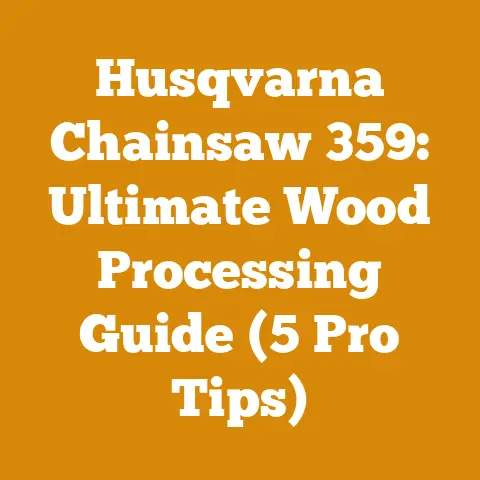Treating Bagworms on Arborvitaes (7 Proven Woodcare Hacks)
Alright, let’s dive into tackling those pesky bagworms on your precious arborvitaes!
As a seasoned woodcare enthusiast, I’ve battled my fair share of infestations, and I’m here to share my tried-and-true methods for keeping these evergreens healthy and thriving.
Forget waiting – let’s get those bagworms gone!
Treating Bagworms on Arborvitaes: 7 Proven Woodcare Hacks
Bagworms!
Just the name sends shivers down the spine of any tree lover.
These critters can wreak havoc on arborvitaes, turning lush green foliage into a brown, unsightly mess.
But don’t despair!
I’ve spent years perfecting my approach to dealing with these pests, and I’m excited to share my knowledge with you.
Let’s explore seven effective woodcare hacks to combat bagworms and keep your arborvitaes looking their best.
Understanding the Enemy: Bagworm Biology and Identification
Before you grab your tools and declare war, it’s crucial to understand your enemy.
Bagworms aren’t actually worms; they’re moth larvae.
They create distinctive silk bags covered in foliage, which serve as both shelter and camouflage.
- Life Cycle: Bagworms typically have one generation per year.
Eggs hatch in late spring to early summer, and the larvae feed throughout the summer.
By late summer, they pupate within their bags, and adult moths emerge in the fall.
The female moths are wingless and remain inside the bag, where they lay their eggs before dying. - Identification: The most obvious sign of bagworms is the presence of their bags.
These bags are usually 1-2 inches long and are made of silk and bits of foliage, making them blend in with the tree.
You might also notice chewed or missing foliage, especially on the inner branches.
Personal Story: I remember one year, I completely missed a bagworm infestation on a row of young arborvitaes.
By the time I noticed the damage, the trees were severely defoliated.
That was a harsh lesson in the importance of regular inspection!
Now, I make it a habit to inspect my trees at least once a week during the growing season.
Hack #1: The Handpicking Method: Simple, Effective, and Satisfying
This is the most straightforward and eco-friendly method, especially for small infestations.
Grab a pair of gloves (trust me, you don’t want to touch those bags directly!) and a bucket.
- Timing is Key: The best time to handpick bagworms is in the late fall, winter, or early spring, before the eggs hatch.
This is when the bags are most visible and the larvae are dormant. - How to Do It: Carefully inspect your arborvitaes for the characteristic bags.
Gently pluck them off and drop them into the bucket. - Disposal: The key here is proper disposal.
Don’t just toss the bags on the ground; the eggs can still hatch.
Either burn them (if local regulations allow), bury them deep in the ground, or submerge them in soapy water for a few days.
Data and Insights: According to a study by the University of Maryland Extension, handpicking can be 90% effective in controlling bagworm populations if done consistently.
Tool List:
- Gloves
- Bucket
Actionable Metric: Aim to remove all visible bags from your arborvitaes.
Check again in a week to ensure you haven’t missed any.
Hack #2: Horticultural Oil: A Safe and Effective Spray
Horticultural oil is a refined petroleum-based oil that suffocates insects.
It’s a safe and effective option for controlling bagworms, especially when they’re young and vulnerable.
- How it Works: Horticultural oil works by coating the bagworms and their eggs, blocking their breathing pores and causing them to suffocate.
- Timing is Crucial: Apply horticultural oil in the spring, shortly after the eggs hatch and the larvae are actively feeding.
This is when they’re most susceptible to the oil. - Application: Follow the manufacturer’s instructions carefully.
Typically, you’ll need to dilute the oil with water and apply it using a sprayer.
Make sure to coat all parts of the tree, including the inner branches where bagworms often hide.
Important Considerations:
- Weather: Avoid applying horticultural oil on hot, sunny days or when temperatures are expected to be below freezing.
- Plant Sensitivity: Some plants are sensitive to horticultural oil.
Test it on a small area of your arborvitae before applying it to the entire tree.
Tool List:
- Horticultural oil
- Sprayer
- Measuring cup
Actionable Metric: Monitor your arborvitaes for signs of bagworm activity after applying horticultural oil.
Reapply as needed, following the manufacturer’s instructions.
Hack #3: Bacillus Thuringiensis (Bt): The Biological Weapon
Bacillus thuringiensis (Bt) is a naturally occurring bacterium that produces a toxin that is deadly to certain insects, including bagworms.
It’s a biological control agent, meaning it’s a natural and environmentally friendly way to control pests.
- How it Works: When bagworms ingest Bt, the toxin disrupts their digestive system, causing them to stop feeding and eventually die.
- Timing is Key: Apply Bt in the spring, shortly after the eggs hatch and the larvae are actively feeding.
The younger the larvae, the more susceptible they are to Bt. - Application: Bt is available in liquid or powder form.
Mix it with water according to the manufacturer’s instructions and apply it using a sprayer.
Make sure to coat all parts of the tree, especially the foliage.
My Experience: I’ve had great success using Bt to control bagworms on my arborvitaes.
It’s a safe and effective option, and it doesn’t harm beneficial insects like bees and butterflies.
Tool List:
- Bt insecticide
- Sprayer
- Measuring cup
Actionable Metric: Check your arborvitaes for signs of dead or dying bagworms after applying Bt.
Reapply as needed, following the manufacturer’s instructions.
Hack #4: Insecticidal Soap: A Gentle Approach
Insecticidal soap is another safe and effective option for controlling bagworms.
It works by disrupting the outer layer of the insect’s body, causing it to dehydrate and die.
- How it Works: Insecticidal soap disrupts the bagworm’s cell membranes, leading to dehydration and death.
- Timing is Important: Like horticultural oil and Bt, insecticidal soap is most effective when applied to young bagworms.
- Application: Follow the manufacturer’s instructions carefully.
Typically, you’ll need to dilute the soap with water and apply it using a sprayer.
Make sure to coat all parts of the tree, including the inner branches.
Important Considerations:
- Weather: Avoid applying insecticidal soap on hot, sunny days or when temperatures are expected to be below freezing.
- Plant Sensitivity: Some plants are sensitive to insecticidal soap.
Test it on a small area of your arborvitae before applying it to the entire tree.
Tool List:
- Insecticidal soap
- Sprayer
- Measuring cup
Actionable Metric: Monitor your arborvitaes for signs of bagworm activity after applying insecticidal soap.
Reapply as needed, following the manufacturer’s instructions.
Hack #5: Systemic Insecticides: The Last Resort
Systemic insecticides are absorbed by the plant and transported throughout its tissues.
When bagworms feed on the plant, they ingest the insecticide and die.
- How it Works: Systemic insecticides are absorbed into the plant’s vascular system, poisoning bagworms as they feed.
- Application: These insecticides are usually applied as a soil drench or trunk injection.
Follow the manufacturer’s instructions carefully. - Caution: Systemic insecticides can be harmful to beneficial insects, so use them as a last resort.
My Perspective: I generally avoid using systemic insecticides unless the infestation is severe and other methods have failed.
It’s important to weigh the risks and benefits carefully before using these products.
Tool List:
- Systemic insecticide
- Measuring cup
- Gloves
Actionable Metric: Monitor your arborvitaes for signs of bagworm activity after applying systemic insecticide.
Follow the manufacturer’s instructions for reapplication.
Hack #6: Pruning: Removing Infested Branches
If the bagworm infestation is localized to a few branches, pruning can be an effective way to remove the pests.
- How to Do It: Use pruning shears to cut off the infested branches.
Make sure to cut back to healthy wood. - Disposal: Dispose of the pruned branches properly.
Don’t just leave them on the ground; the bagworms can still hatch.
Either burn them, bury them, or submerge them in soapy water.
Tool List:
- Pruning shears
- Gloves
- Bucket
Actionable Metric: Inspect your arborvitaes regularly after pruning to ensure that the bagworm infestation is under control.
Hack #7: Promoting Healthy Trees: The Best Defense
Healthy trees are more resistant to pests and diseases.
By promoting the health of your arborvitaes, you can make them less susceptible to bagworm infestations.
- Proper Watering: Water your arborvitaes deeply and regularly, especially during dry periods.
- Fertilizing: Fertilize your arborvitaes in the spring with a balanced fertilizer.
- Mulching: Apply a layer of mulch around the base of your arborvitaes to help retain moisture and suppress weeds.
- Proper Pruning: Prune your arborvitaes regularly to remove dead or diseased branches and to improve air circulation.
Personal Insight: I’ve found that healthy, well-maintained arborvitaes are much less likely to be severely affected by bagworms.
Prevention is always better than cure!
Actionable Metric: Develop a regular maintenance schedule for your arborvitaes, including watering, fertilizing, mulching, and pruning.
Advanced Woodcare: Understanding Arborvitae Health
Taking care of your arborvitaes goes beyond just treating bagworms.
Understanding their needs and providing optimal conditions will make them more resilient.
- Soil Testing: Conduct a soil test to determine the pH and nutrient levels of your soil.
Arborvitaes prefer slightly acidic soil. - Root Health: Ensure proper drainage to prevent root rot.
Avoid overwatering, especially in heavy clay soils. - Sunlight: Arborvitaes need at least six hours of sunlight per day.
Common Mistakes to Avoid
- Ignoring Early Signs: Don’t wait until the infestation is severe to take action.
Early detection and treatment are crucial. - Improper Application of Insecticides: Always follow the manufacturer’s instructions carefully when applying insecticides.
- Neglecting Tree Health: Healthy trees are more resistant to pests and diseases.
Keeping Tools Sharp and Ready
Maintaining your tools is crucial for effective woodcare. Here are some tips:
- Pruning Shears: Clean and sharpen your pruning shears regularly.
A sharp blade will make clean cuts and prevent the spread of diseases. - Sprayers: Rinse your sprayers thoroughly after each use to prevent clogging.
- Gloves: Use sturdy gloves to protect your hands from thorns and chemicals.
Conclusion: A Proactive Approach to Bagworm Control
Treating bagworms on arborvitaes requires a proactive approach.
By understanding the pest, implementing the right control methods, and promoting the health of your trees, you can keep your arborvitaes looking their best.
Remember, consistency is key.
Regularly inspect your trees, take action early, and don’t give up!
With a little effort, you can win the battle against bagworms and enjoy the beauty of your arborvitaes for years to come.
Now, go forth and protect those trees!






